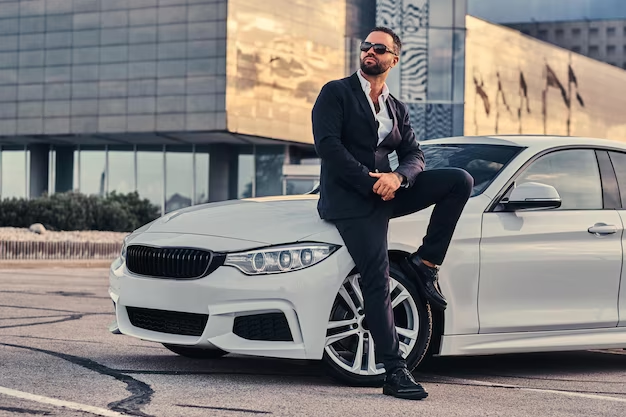Introduction
Luxury cars have always been more than just modes of transportation—they are expressions of art, engineering, and status. From the hand-stitched leather seats of a Rolls-Royce to the cutting-edge electric drivetrains of a Tesla, luxury cars represent the pinnacle of automotive sophistication. Over the years, the luxury car market has evolved from focusing solely on comfort and power to embracing sustainability, smart technology, and autonomous driving.As the automotive industry faces rapid technological changes and growing environmental consciousness, luxury car manufacturers are redefining what it means to drive in style.

The Evolution of Luxury Cars
Luxury cars have come a long way from their origins in the early 20th century, when bespoke coach-built cars were reserved for the elite. Over time, technological advancements, changing consumer preferences, and economic shifts have shaped the luxury car market.
Early Luxury Cars – Symbols of Status and Craftsmanship
The earliest luxury cars, such as the Rolls-Royce Silver Ghost (1906) and the Mercedes-Benz 770 (1930), were handcrafted masterpieces designed for royalty and aristocrats.
These cars featured opulent materials such as genuine leather, polished wood, and even precious metals.
Performance was secondary to comfort and exclusivity, with many early luxury cars built for chauffeur-driven use.
Post-War Era – Rise of Performance and Engineering Excellence
The 1950s and 1960s saw luxury brands like Bentley, Ferrari, and Aston Martin introducing high-performance engines to complement their elegant designs.
The introduction of automatic transmissions, air conditioning, and power steering made luxury cars more comfortable and accessible.
Brands like Jaguar and Porsche combined luxury with motorsport-inspired engineering, creating cars that were both comfortable and powerful.
Modern Luxury – Technology Meets Comfort
The 21st century saw the rise of smart infotainment systems, adaptive cruise control, and hybrid powertrains.
Mercedes-Benz, BMW, and Audi integrated AI-driven driver assistance, gesture controls, and voice commands into their high-end models.
Sustainability and performance began to converge as electric and hybrid powertrains offered the best of both worlds—silent, emission-free driving combined with rapid acceleration.
The Core Elements of Modern Luxury Cars
Today’s luxury cars are defined by a blend of comfort, performance, technology, and sustainability. Automakers strive to create a holistic experience that engages all the senses while delivering uncompromising power and style.
Design and Materials
Luxury car manufacturers spare no expense when it comes to design and materials.
Exterior Craftsmanship – Precision-cut body panels, bespoke paint finishes, and signature lighting give luxury cars a distinct presence on the road.
Handcrafted Interiors – Soft leather, natural wood veneers, carbon fiber accents, and metal finishes create a rich and inviting cabin.
Sustainable Materials – Many luxury brands are adopting vegan leather, recycled fabrics, and eco-friendly woods to reduce environmental impact.
Performance and Engineering
Performance remains a key pillar of luxury cars, but it is now balanced with efficiency and refinement.
Powerful Engines – Twin-turbocharged V8s, hybrid drivetrains, and electric motors provide effortless acceleration.
Dynamic Suspension – Adaptive air suspension and active damping adjust to road conditions for a smooth and stable ride.
All-Wheel Drive and Rear-Wheel Steering – Enhanced traction and cornering stability make luxury cars as nimble as they are powerful.
Technology and Connectivity
Luxury cars are now as technologically advanced as they are comfortable.
Infotainment – High-resolution touchscreens, augmented reality (AR) navigation, and voice assistants create a connected driving experience.
AI and Machine Learning – AI-driven driver assistance systems learn driving patterns and anticipate needs.
Over-the-Air (OTA) Updates – Luxury brands like Tesla, BMW, and Mercedes-Benz provide continuous software updates to enhance performance and features.
Personalization
The future of luxury is not just about the car—it’s about the experience.
Bespoke Options – Custom paint colors, monograms, and interior trims allow buyers to create one-of-a-kind vehicles.
Smart Settings – AI systems adjust seat positions, climate control, and driving modes based on the driver’s habits and preferences.
Mood Lighting and Soundscapes – Ambient lighting and sound profiles create a tailored atmosphere inside the cabin.
Electric Revolution in Luxury Cars
Electrification is transforming the luxury car market, with major brands committing to fully electric lineups in the coming decades. Electric powertrains offer significant advantages in terms of performance, efficiency, and environmental impact.
Performance Advantages of Electric Powertrains
Instant Torque – Electric motors provide immediate acceleration, with some models reaching 0–60 mph in under 2 seconds.
Quiet Operation – Electric powertrains reduce engine noise, creating a more serene driving experience.
Lower Center of Gravity – Battery placement lowers the car’s center of gravity, improving handling and stability.
Leading Luxury Electric Models
Rolls-Royce Spectre – The first all-electric Rolls-Royce features a dual-motor setup and delivers a range of over 300 miles.
Tesla Model S Plaid – Known for its blistering acceleration and cutting-edge autonomous driving capabilities.
Porsche Taycan – Combines sports car handling with luxury and electric efficiency.
Autonomous and AI-Powered Driving
The future of luxury cars is autonomous. AI-driven systems are rapidly improving in capability, making fully autonomous driving closer to reality.
Levels of Autonomy
Level 2 – Most luxury cars today feature advanced driver assistance (lane-keeping, adaptive cruise control).
Level 3 – Mercedes-Benz and Audi are testing systems that allow hands-free driving under certain conditions.
Level 4 and 5 – Fully autonomous systems are expected to debut within the next decade.
AI Integration
AI systems analyze traffic patterns, road conditions, and driver behavior to optimize performance.
Machine learning enables predictive maintenance and proactive service alerts.
AI-driven infotainment systems adjust music, lighting, and climate control based on driver preferences.
Sustainability and Eco-Luxury
Luxury car brands are embracing sustainability without compromising quality or performance.
Eco-Friendly Materials
Bentley and Rolls-Royce now offer interiors crafted from sustainable wood and vegan leather.Recycled plastics and natural fibers are becoming common in high-end models.
Carbon-Neutral Manufacturing
BMW’s plant in Dingolfing, Germany, is powered by renewable energy and produces the all-electric BMW i7.Volvo and Mercedes-Benz have committed to carbon-neutral manufacturing by 2030.

Conclusion
The future of luxury cars is defined by a harmonious blend of tradition and innovation. While classic craftsmanship and high-performance engineering remain central to the luxury experience, the rise of electric powertrains, AI integration, and sustainable materials is transforming the industry. Brands like Rolls-Royce, Bentley, and Tesla are leading the way, proving that luxury and environmental responsibility can coexist.Luxury cars will continue to evolve, but their core values of elegance, power, and exclusivity will endure.

